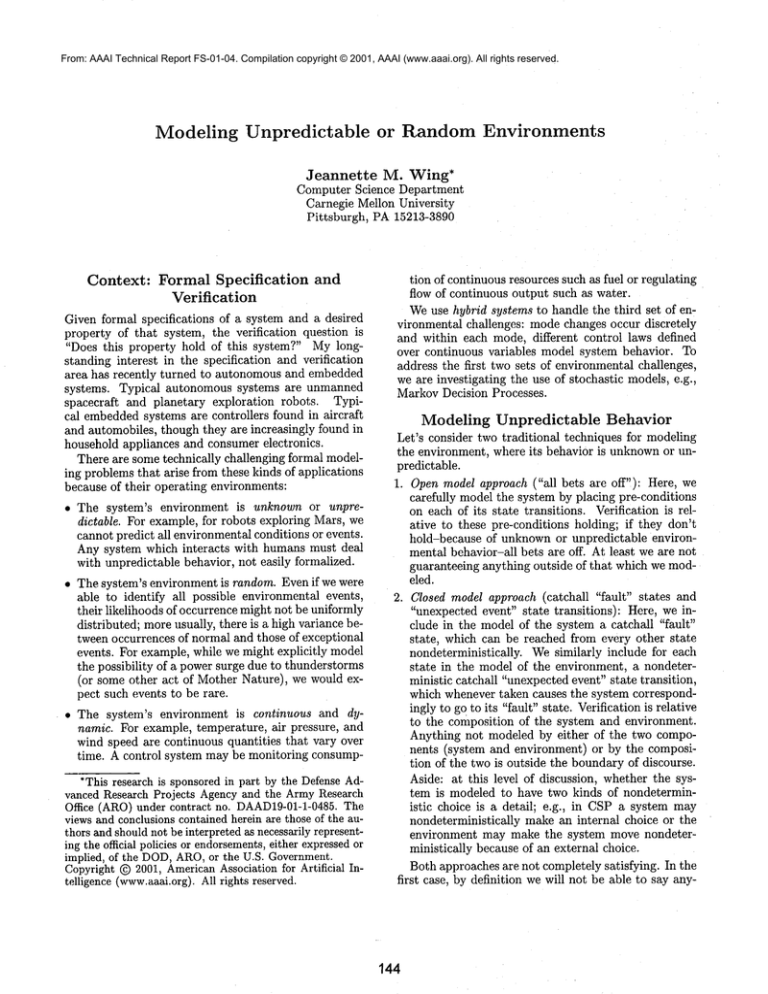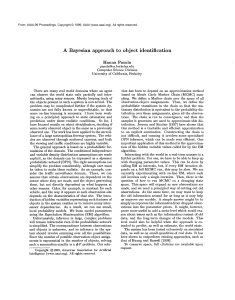
From: AAAI Technical Report FS-01-04. Compilation copyright © 2001, AAAI (www.aaai.org). All rights reserved.
Modeling
Unpredictable
or Random Environments
Jeannette
M. Wing*
Computer Science Department
Carnegie Mellon University
Pittsburgh, PA 15213-3890
Context:
Formal Specification
Verification
and
Given formal specifications of a system and a desired
property of that system, the verification question is
"Does this property hold of this system?" Mylongstanding interest in the specification and verification
area has recently turned to autonomous and embedded
systems. Typical autonomous systems are unmanned
spacecraft and planetary exploration robots. Typical embeddedsystems are controllers found in aircraft
and automobiles, though they are increasingly found in
household appliances and consumer electronics.
There are some technically challenging formal modeling problems that arise from these kinds of applications
because of their operating environments:
¯ The system’s environment is unknown or unpredictable. For example, for robots exploring Mars, we
cannot predict all environmental conditions or events.
Any system which interacts with humans must deal
with unpredictable behavior, not easily formalized.
¯ The system’s environment is random. Even if we were
able to identify all possible environmental events,
their likelihoods of occurrence might not be uniformly
distributed; more usually, there is a high variance between occurrences of normal and those of exceptional
events. For example, while we might explicitly model
the possibility of a power surge due to thunderstorms
(or some other act of Mother Nature), we would expect such events to be rare.
¯ The system’s environment is continuous and dynamic. For example, temperature, air pressure, and
wind speed are continuous quantities that vary over
time. A control system may be monitoring consump*This research is sponsored in part by the Defense Advanced Research Projects Agency and the ArmyResearch
Office (ARO)under contract no. DAAD19-01-1-0485.
The
views and conclusions contained herein are those of the authors and should not be interpreted as necessarily representing the official policies or endorsements,either expressedor
implied, of the DOD,ARO,or the U.S. Government.
Copyright(~) 2001, AmericanAssociation for Artificial Intelligence (www.aaai.org).All rights reserved.
tion of continuous resources such as fuel or regulating
flow of continuous output such as water.
Weuse hybrid systems to handle the third set of environmental challenges: modechanges occur discretely
and within each mode, different control laws defined
over continuous variables model system behavior. To
address the first two sets of environmental challenges,
we are investigating the use of stochastic models, e.g.,
Markov Decision Processes.
Modeling
Unpredictable
Behavior
Let’s consider two traditional techniques for modeling
the environment, where its behavior is unknownor unpredictable.
1. Open model approach ("all bets are off"): Here,
carefully model the system by placing pre-conditions
on each of its state transitions. Verification is relative to these pre-conditions holding; if they don’t
hold-because of unknown or unpredictable environmental behavior-all bets are off. At least we are not
guaranteeing anything outside of that which we modeled.
2. Closed model approach (catchall "fault" states and
"unexpected event" state transitions):
Here, we include in the model of the system a catchall "fault"
state, which can be reached from every other state
nondeterministically. Wesimilarly include ibr each
state in the model of the environment, a nondeterministic catchall "unexpected event" state transition,
which whenever taken causes the system correspondingly to go to its "fault" state. Verification is relative
to the composition of the system and environment.
Anything not modeled by either of the two components (system and environment) or by the composition of the two is outside the boundaryof discourse.
Aside: at this level of discussion, whether the system is modeled to have two kinds of nondeterministic choice is a detail; e.g., in CSPa system may
nondeterministically make an internal choice or the
environment may make the system move nondeterministically because of an external choice.
Both approaches are not completely satisfying. In the
first case, by definition we will not be able to say any-
144
thing about unknownbehavior. It’s a conservative approach because it qualifies under what conditions we answer "yes" to the verification question (i.e., only when
the pre-conditions hold). In the second case, we will
ahnost always answer "no" because we can always take
the environment’s "unexpected event" transition and
go to the system’s "fault" state. Answering "no", however, is uninteresting. What we really want to be able
to assert is that under the highly likely normal conditions, the system will behave correctly.
Modeling Stochastic
kind of progress is reasonable to expect in the near future? Whatare the pitfalls I should avoid in trying to
apply these models?
References
Baier, C., and Kwiatkowska, M. 1998. Model checking
for a probabilistic branching time logic with fairness.
Distributed Computing (11):125-155.
Bansson, H., and Jonsson, B. 1994. A logic for reasoning about time and probability. Formal Aspects of
Computing 6(5):512-535.
Bianco, A., and de Alfaro, L. 1995, Model checking of
probabilistic and nondeterministic systems. In Foundations of Software Technology and Theoretical Computer Science, LNCS1026, 499-513. Springer Verlag.
Bozga, M., and Maler, O. 1999. On the representation
of probabilities over structured domains. In Proc. of
CAV’99, LNCS1633. Springer-Verlag.
Clarke, E.; Fujita, M.; McGeer,P.; Yang, J.; and Zhao,
X. 1993. Multi-terminal binary decision diagrams: An
efficient data structure for matrix representation. In
IWLS 93: International Workshop on Logic Synthesis.
de Alfaro, L.; Kwiatkowska, M.; Norman, G.; Parker,
D.; and Segala, R. 2000. Symbolic model checking
of probabilistic processes using mtbdds and the kronecker representation. In TACAS2000. Springer Verlag.
Segala, R., and Lynch, N. 1994. Probabilistic
simulations for probabilistic processes. In CONCUR’9~,
LNCS836, 481-496. Springer Verlag.
Wu, S.-H.; Smolka, S.; and Stark, E. 1997. Composition and behaviors of probabilistic I/O automata.
Theoretical ComputerScience (176):1-38.
Behavior
To address the second set of challenges in modeling a system’s environment, specification and verification researchers have used probabilistic models, e.g.,
stochastic transition systems (de Alfaro et al. 2000)
and probabilistic I/O automata (Segala & Lynch 1994;
Wu, Smolka, & Stark 1997) and probabilistic
logics, e.g., Probabilistic Computation Tree Logic (Bansson & Jonsson 1994) and Probabilistic
Branching
Time Logic (Baier & Kwiatkowska 1998). For example, PCTLformulae are interpreted over finite state
discrete-time Markovchains. The logic is very expressive and has a model checking algorithm that can be
implemented using techniques based on Multi-Terminal
Binary Decision Diagrams (Bianco & de Alfaro 1995;
Clarke et al. 1993). MTBDDsrepresent transition
probability matrices and differ from Binary Decision Diagrams in that the leaves may have values other than 0
and 1; in particular, the leaves contain transition probabilities. Others (Bozga & Maler 1999) use Probabilistic Decision Graphs to represent probability functions;
and Conditional PDGs, Markov transition
functions.
PDGslabel all nodes, not just leaf nodes, with probabilities;
CPDGsextend PDGsto handle undetermined
variables.
Unfortunately, in my preliminary discussions with
colleagues, some of whominvented the techniques and
data structures discussed above, I get a very skeptical
response toward the use of stochastic models to reason about uncertainty or randomness. I would like to
understand why:
¯ Is it because the state spaces are so unreasonably
large to be impractical? Howimpractical?
¯ Is it because no one knowswhere the numbers, i.e.,
probability distributions, come from?
¯ Is it because the mathematical models are inadequate
in some ways? What ways? Or perhaps too unwieldy? Why?
What I Hope to Learn from the
Workshop
What I would like to get from this workshopis a better
sense of the foundational and practical limitations of
models, in particular stochastic models, for reasoning
about uncertainty. Of these current limitations, what
145






